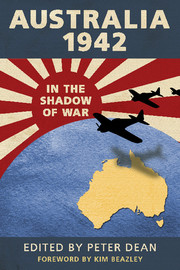Book contents
- Frontmatter
- Foreword
- Contents
- Photos
- Maps
- Charts
- Acknowledgements
- Contributors
- Abbreviations
- Maps
- Introduction
- Part 1 Australia in 1942
- Part 2 Relations, politics and the home front
- Part 3 Australia under threat
- Part 4 The war on Australia’s doorstep
- Chapter 9 Vanquished but defiant, victorious but divided
- Chapter 10 A novel experience
- Chapter 11 On Australia’s doorstep
- Chapter 12 Anzacs and Yanks
- Conclusion
- Index
- References
Chapter 12 - Anzacs and Yanks
US and Australian operations at the Beachhead battles
from Part 4 - The war on Australia’s doorstep
Published online by Cambridge University Press: 05 January 2013
- Frontmatter
- Foreword
- Contents
- Photos
- Maps
- Charts
- Acknowledgements
- Contributors
- Abbreviations
- Maps
- Introduction
- Part 1 Australia in 1942
- Part 2 Relations, politics and the home front
- Part 3 Australia under threat
- Part 4 The war on Australia’s doorstep
- Chapter 9 Vanquished but defiant, victorious but divided
- Chapter 10 A novel experience
- Chapter 11 On Australia’s doorstep
- Chapter 12 Anzacs and Yanks
- Conclusion
- Index
- References
Summary
An easy victory?
The re-capture of Kokoda on 2 November 1942, followed by the battle of Oivi-Gorari (4–11 November), heralded a major victory for the Australians in Papua. To both the US and Australian high commands and their troops it seemed that the main Japanese force in Papua had been defeated and that the clearing of the Japanese from the north coast of Papua, around Gona, Buna and Sanananda, would be a quick and relatively easy objective. Once this area was secured the Allies could then start developing the area for their planned counter attack to retake the Japanese strong hold at Rabaul.
As the 7th Australian Division, under Major-General George Vasey, descended out of the Owen Stanley Range and advanced onto the low-lying ground near the Japanese bases on the coast, Lieutenant-General Edmund Herring opened Advanced New Guinea Force Headquarters (Adv NGF HQ) at Popondetta. This headquarters was to command both the 7th Division and the recently arrived US 32nd Infantry Division.
By this time the plans of the Australian C-in-C, General Sir Thomas Blamey, for the capture of the Japanese beachhead bases was well advanced. His thrust was to be along three axes, the 7th Division driving down from the Kokoda Trail to Gona and Sanananda while two regiments of the US 32nd Division, under Major-General Edwin Harding, advanced to Buna via a combined air, sea and land route. By mid-November the final orders had been set, with the Girua River acting as the boundary between the two divisions. The Allies were reasonably confident of success with General Douglas MacArthur’s General Headquarters, South West Pacific Area (GHQ) estimating that only 4000 Japanese troops occupied the entire area.
- Type
- Chapter
- Information
- Australia 1942In the Shadow of War, pp. 217 - 239Publisher: Cambridge University PressPrint publication year: 2012

